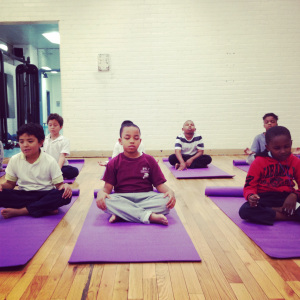I love coming home. This is ironic since I basically ran away to a Connecticut boarding school at age fourteen with hopes of finding Mrs. Drummond and the girls of the 80s sitcom The Facts of Life. I longed to escape the depressed city (for Black people) of Milwaukee, WI and thereby disappear into my fantasy of what life could be. In recent years, I find I rest more completely and deeply here than any other place on Earth (save those near idyllic tropical beaches). I stand in the bedroom doorway of a sun-drenched room, basking in the bright light, regarding the soft cream-colored carpet, the lightly stained wood furniture and the cream and wintergreen duvet accents. Stepping further inside, I look through the window of another door that leads to a wide balcony, complete with a table and chairs that overlooks the long backyard below. It all looks so peaceful and serene. This same room was the meditation room in my childhood home, though this Christmas it is occupied by my youngest sister. She inherited the space as her own after my parents separated years ago. Ironically, the room feels more peaceful and infused with positive energy now than it did as the meditation room it was when we were children.
Created by my father when my parents moved here in 1975, the meditation room was meant to be a place to commune with the Divine and find ways to explore our highest potential as human beings and as a family. Yup, that all seemed totally normal to me then. I mean, doesn’t everybody have a mediation room in their house? The space was darker then, the walls and carpet stained considerably from the thick smoke of burning incense and candles. The deep red, blue, beige, and black hues of a carpet my father bought on a trip to India darkened the brightness of the room, and a tall bookshelf filled with books representing every spiritual tradition on Earth (there was even a crystal ball covered by purple velvet!) created shadows and blocked the natural light that might otherwise saturate and warm the space. There was a wicker love seat with cushions against a wall, and an all-inclusive altar that did not discriminate among the deities and prophets enshrined there. It was remarkable that in this room the many teachings of The Bible, The Koran, Hinduism, and the Buddha, among others, all abided harmoniously. What a profoundly open-minded perspective on spirituality I had exposure to, starting at such an early age! I now appreciate this exemplary of enlightened consciousness on my father’s part, and to be a true blessing in the world we live in, one rife with religious conflict and misunderstanding. One of my favorite books to read and teach my former literature students was The Life of Pi, for these very reasons. Pi Patel, the protagonist, beautifully characterizes the profound kinship that can be found by embracing what’s “good” in multiple religions. He and I would have a lot to talk about, if only he were a real person. What a gift my father gave me with this early immersion on embracing the virtues of diverse perspectives. Yet and still, this space, my childhood meditation room, was somehow the root of personal conflict and confusion for me, and perhaps all of my family when it existed.
To be honest, it has taken me nearly my whole life so far to begin to understand more completely the practice of meditation and its potentially revolutionary impact on my life. I sit daily now of my own accord, but as a child, it seemed to be forced on me, this oppressively quiet time during my youth, when the thoughts, questions, and ideas in my mind were naturally engaged full speed ahead. Today the ritual grounds me, a self-directed exploration of whatever is resonating for me. Meditating before I head out into the challenges of my New York City teaching and acting life helps me connect meaningfully with myself first, so that I may do so more authentically and empathetically with others. Though my father’s instructional intentions were well-meaning, my first lessons from him on how to meditate were convoluted, confusing, and well, terribly boring for a five-year old. I thought it looked so cool when he did it, though. I would peek through the crack in the meditation room door and be baffled by his ability to look like he was sleeping while sitting up, and yet be totally awake, and for what seemed like hours! He encouraged my curiosity. And I may have been the most curious of all my siblings. Meditation with my dad over the years included chanting, mantras, focusing my gaze on the flickering light of a candle, among other methods to encourage concentration for my rapid-fire internal rhythms. But one key message and benefit I missed completely then was the idea that meditation had the potential impact of making one more mindful, peaceful and even kind to oneself or others. Perhaps it was lost on his Indian guru as well, Swami Rama who founded the International Institute of Yoga Science and Philosophy in Rishikesh, or the small congregation of The Self-Realization Fellowship of Paramahansa Yogananda fame, where our family attended services together when I was young. I don’t know. Though my father was disciplined in many ways and deeply devoted to his practice, he struggled to embody these warmer relational qualities. Therefore the practical day to day values inherent in yoga were mostly lost on me as a child, and it took years for me to cultivate a personal practice that would positively impact my life.
As it seems the case for my father and a number of startlingly mean-spirited yogis that I’ve encountered over the years, the concept of “taking one’s yoga off the mat and into the world” or simply “into the family, classroom and community” can sometimes get lost on modern practitioners. As an adult I now realize that the sting of my dad’s often critical tongue, and the infrequent use of positive reinforcement when I faced a challenge made surprisingly deep wounds in my ability to maintain self-esteem and self-soothe. In recent years even some of my choices of yoga mentors have revealed some karmic drama to play out with these types. Without intervention, it’s practically a guarantee that we all inherit our parents’ model of communication, manner of demonstrating love, and family values without the benefit of knowledge of alternative ways of being with each other. In the Black community, our unique history as slaves, perceived as inhuman and therefore invalid in the eyes of our oppressors, seems to have contributed to many distorted methods for expressing love, affection, and even discipline within some of our familial relationships and how we attune emotionally to one another’s needs. I’ve definitely not escaped unharmed. For myself, learning how to attend to my own sometimes biting tongue or a quickness in temper is a constant practice. Today I choose my yoga mentors more wisely. Through the wisdom, mindfulness, and activism of teachers like Thich Nhat Hahn, Maya Breuer, Rolf Gates, Jana Long, and my students, I am learning to be a yogi both on and off the mat.
Over the years, I’ve learned more about my father’s painful childhood, the inhumane racism he suffered as a Black adolescent and young man growing up in the tumultuous 50s and Civil Rights era 60s in Wisconsin. A few years ago, a fraction of his suffering was captured in a Milwaukee museum exhibit called Black Thursday about the University of Wisconsin-Oshkosh riots in the 60s featured my father, the Black Student Union president, my mother (his girlfriend at the time), and my Aunt Sandra (my dad’s sister), among many others. The realization that their late teens and 20s included the death of Martin Luther King Jr., Malcolm X, and John F. Kennedy and that they still managed to take a stand for what they believed in still takes my breath away. I wondered if meditation had become an obsession for my dad, a therapeutic method (as narcissistic as it seemed to be at times) of ignoring or reinforcing his own trauma-induced personal issues. I have deep compassion for this man, and many other students and teachers that I’ve encountered in yoga studios who seem to show up to class for similar reasons. Yoga and meditation are teaching me to practice empathy toward them and myself. Like all of us, he has always done his best with the tools he’s been given in a perfectly flawed and unpredictable life.
It all makes so much sense now, as I stand in the doorway of my childhood meditation room and reflect on my yoga roots: why I do what I do. My goal as a teacher is to make yoga accessible to ALL my students. It is my hope that they walk away from each class with a concrete tool for managing stress, for self-understanding, and for navigating the challenges of their lives. As a teacher of yoga to diverse adults students and New York City youth, it is easy to imagine what would have made the practices of yoga and meditation meaningfully relevant for me at their ages. I was and still am a busy body, and so in my classes we move A LOT. But my students, adults and children, also know that there is great value in being still. We go fast AND practice being slow and mindful. We sing and we even dance. We chant, clap, stomp, snap, and even shout, all with the ultimate goal of learning to maneuver mindfully and discerningly through our moment to moment lives. Through them I see everyday that it is possible to do this. It might take years for the original yogic seed to grow and begin to blossom. Nevertheless, with attention and effort, it is possible to wake up one day and see yourself like never before and still recognize that this is the you that was always there, waiting to be revealed.

